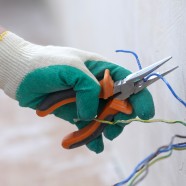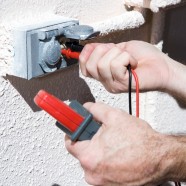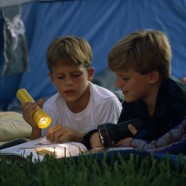How to Run New Wires Through Your Home’s Old Walls
If you’re buying an older house, or your family has grown since you bought your existing home, remodeling and renovation are probably on your mind. Bathroom and kitchen remodeling are the most popular renovation jobs in the country, but you’ll have to think about residential wiring no matter what room you want to work on. Electrical remodeling can be as simple as adding an outlet or as complex as creating an entirely new circuit for part of a room. While elaborate jobs should always be left up to professional electricians, you can do some simple tasks if you’re confident with basic tools.
Preparing for the Job
Doing your own electrical remodeling is only possible if you’re fanatical about the safety rules. If you never cut any corners you’ll be able to do some simple jobs, but if you’re the type to take shortcuts, then rather leave the job to the professionals.
If you do want to proceed with the project, begin by turning off the power to the room at the breaker box. If it’s too dim in the room, use bright flashlights to see your work. Use a voltage tester to make sure the outlet you’ll be working on doesn’t have any power going to it. Once you’re sure there is no power running to the outlet, remove any objects hanging on the walls in that area, such as televisions or paintings. Use a stud finder to locate the studs in the wall, and mark them with a pencil.
Making the Cuts
The phrase “measure twice and cut once” may never be more important as it is in reference to making holes in your wall. Be very strategic in the placement of the holes so that you don’t make larger ones than necessary.
Measure and draw outlines with a pencil for all the drywall holes you need to make. Cut a hole across all studs for easier access to the area you’ll be working in. Use a drywall saw to make clean cuts, and set each square aside after you remove it. You’ll be replacing these squares when the electrical work is finished. If you’ll be traveling the wire for the length of the wall, cut an interim hole to help you to guide it to its final destination.
Use a right-angle saw with a round bit to cut holes through the studs for the wires to go through. You can rent these specialty saws through some hardware stores and most home improvement centers. If you’ll be running multiple cables through the wall, such as for a wall-mounted television, drill a separate, larger hole for holding conduit.
Running the Wires
Begin at the highest point and run the wires down through the inside of the wall. Gravity will help the wire to go where you want it to, but if you have any problems sending the wire to the right place, use fish tape to guide it. Fish tape, otherwise known as an electrician’s snake, is a long coil of wire designed to help pull wires through long expenses of wire. It’s coiled up but stiff, much like a metal measuring tape.
Feed the end of the tape through one hole in the wall and feed it toward the other end. Once you see the end of the fish tape, attach it to the wire and coil the tape back up. The wire will follow along, emerging exactly where you need it. From there, you can proceed with installing your outlet.
Professional Help
Some small jobs covering small areas of the wall can be done by amateurs, but if you’re considering a large electrical remodeling job, allow a licensed electrician to do the job. They know exactly how to move wires through walls, the optimal spot for all new outlets, and the safest way to finish the job. Doing elaborate wiring work on your home is no job for a beginner. Electrical fires take out thousands of homes each year, and many of them could be avoided by using better electrical safety methods. Call a professional for anything but the simplest job, and even then if you’re not certain of every step to take to complete a safe and neat job.
Read More6 Types of Power System Protection
Florida’s power systems are taxed more than most states because of the extraordinary amount of lightning that strikes the state each year. You don’t need bad weather to experience power fluctuations, though. Voltage can ebb and spike for multiple reasons, causing anything from mild annoyance to life-endangering problems. The aim of the electrical protection plan is to isolate and fix the problem while keeping as much of the system running as usual. Different problems call for different solutions, but they all work together to keep the power running as normally as possible.
Transformers
Electrical voltage may vary between the power station and your home or business, and transformers work to raise or lower the voltage to the desired rate. They’re the first defense against overloading and brownouts, making use of electromagnets to keep the power steady as it feeds into your building. The resulting power is easier for the relays and breakers in your home or business to deal with.
Protective Relays
Relays are the electrical protection mechanisms that sense an increase in the power supply and trip the circuit breakers. When the power surges too high it can create a fire hazard. Relays prevent that by breaking the circuit through the use of breakers. They’ll work continuously, tripping the same breaker over and over again until the cause of the surge or excess draw is corrected or removed.
Circuit Breakers
Circuit breakers are the workhorses of the power system protection group. Connected to a system of relays, when the power surges too high it will trip, cutting off the power and saving delicate electronics you own. Power won’t flow through an incomplete circuit, and the relays in a circuit breaker are the simplest types to use.
In older buildings there may be a fuse box that employs a system of fuses that burn out when the relay trips. These have to be replaced, though, making the circuit breaker switches a great improvement. Circuit breakers can be simple setups serving only one outlet, as in ground fault circuit interrupters (GFCI) or in a traditional circuit breaker box panel that controls a series of circuits throughout the building.
Back Up Power Supplies
For homes and businesses with one or two computers, a battery operated backup system can be the perfect solution to surges and power outages. These devices are a link between the computer and the wall outlet. If the power goes out a battery backup system instantly creates enough power to run the computer or appliance for about half an hour. This gives you time to shut the computer down properly without losing important data. It also acts as a buffer, preventing surges from damaging delicate data storage. Most of these backups have rechargeable batteries installed, and constantly recharge themselves from the outlet power.
Lightning Protection
All the back power in the world won’t handle a direct lightning strike on your building. Air terminals, what used to be called lightning rods, focus the lightning’s power away from the building and directs it into a grounded area outdoors. It’s a myth that air terminals attract lightning. What they do is to protect your property from any lightning that does happen to strike. You can install lightning protection on your home or business, and can even have specialty protection added to important landscape details such as tall trees and large shrubbery.
Generators
Backup generators don’t prevent a power surge or dip from happening, but when there is a loss of power they immediately start up, preventing the damage that sharp dips and rises in the power system can do to computers, stereo systems, medical devices, and other items that need a constant power source. When your business or your health depend on keeping a constant power supply, it’s crucial to install a reliable backup generator capable of putting out enough power to run critical systems in your building.
Read MoreThe Role Electrical Maintenance Plays in Home Safety
For busy people, having an electrical maintenance contract can be a great time saver. No more worrying about finding spare time to do all the maintenance around the house. No more wondering if you’ve done everything you’re supposed to. But that’s not the only reason to sign up for maintenance agreements. Having regular electrical maintenance appointments can be a key factor in your home safety in multiple ways.
Fire Hazards
One of the leading causes of home fires is problems with electrical wiring. The heat from electrical wiring can degrade and eventually break down their protective covering, leaving bare wires which can easily spark and start a fire inside your home’s walls. You may be able to tell some of the more obvious signs of old wiring such as:
- Breaker switches going off frequently
- Brown, discolored wall outlets
- Getting shocked when you plug in or touch an appliance
The problem is that once these signs are visible the trouble with your wiring has become a serious danger. Residential electrical contractors are trained to discovered problems with your wiring and electrical system before they become dangerous. Your contractor will perform regular electrical maintenance, repairing or replacing parts that have begun to wear out before they get to the point where they might start a fire.
Outdoor Lighting
Your electrical maintenance contract can include your outdoor lighting system, both in landscapes and on paths and buildings. When your contractor replaces bulbs on a regular basis and installs brighter bulbs to illuminate outside your home, it’s safer in two ways. First, brighter lights along walkways and on porches make it easier to walk into your home after dark, cutting down on the problem of tripping over objects you can’t see. Guests to your home can safely walk on unfamiliar paths, as well.
In addition, having reliable bright lighting outside your home is a great burglar deterrent. Most thieves don’t like to operate in bright light; they prefer breaking into homes when it’s dark and difficult for anyone to see them. Bright lights on your porch and motion-activated floodlights on your property can repel all but the most determined burglar.
HVAC
For some people, having the HVAC system in their home working well isn’t just a convenience, it’s a matter of life and death. Senior citizens, especially, are vulnerable to extreme heat variations on both ends of the thermometer. A furnace that goes out in the dead of winter in the north or a power outage that prevents air conditioning from working in Florida can be a danger to the youngest and oldest members of your family.
Allergies are a huge problem for some people here in southern Florida, and many HVAC units are equipped with filters that screen out molds and pollen. If you’ve got a child or other family member with extreme allergies, keeping that filtered air moving is a bit priority, and regular maintenance is the best way to make that happen.
Your contractor can find problems before they start, making electrical repairs while they’re still minor inconveniences and reducing the chance of you having to suffer through a dangerous heat wave without air conditioning.
The DIY Fan
Some families have a member who’s an avid DIY fanatic. They’re convinced they can do every repair necessary on their own home. Unfortunately, many of these people suffer serious shocks when trying to repair or replace their own electrical wiring or appliances. Some simple repairs are easy enough to do yourself, but not all wiring troubles are in a DIYer’s knowledge base. If you have an electrical maintenance agreement with a professional contractor, he’ll spot and repair any problems before your DIY fan can even find them, in most cases. If not, a valid response to them is to ask them to wait for the contractor instead of wasting money they’ve already spent.
Read MoreWhy Energy Conservation Efforts Aren’t Working
In the 70’s it was called ecology. Today it’s the green movement. Whatever you call it, energy conservation has the lofty goal of making the earth a better place to live by using less energy. Energy conservation has been the watchword for decades, and yet we’re still wasting money and using more power than ever before. Since cutting back and using alternate sources of power can result in large energy savings, why aren’t more people doing everything they can to reduce their energy usage?
It’s all about the numbers. The more people who join in trying to conserve energy, the better off we’ll be. The participants benefit, and society does as well. The problem is convincing more people to take the time and make the effort to work toward more energy efficiency.
It’s Got a Bad Name
One of the biggest problems is the perception of the green movement. Just mention “living a greener life” and many people will roll their eyes, visualizing vegan hipsters or old-school hippies. The message needs to be more about energy savings, and less about energy conservation. People are naturally more interested in benefits to themselves than those for society. Appealing to people’s better instincts is a hard way to convince them to act.
There Aren’t Enough Good Examples
It’s the simple things that count. One person pulling out their reusable grocery bags is often looked on as an oddball. But when it becomes the trendy thing to do, the masses fall right in line. The more people who practice energy conservation, the more normal and natural it will appear. The key is getting that first snowball made so that it can roll down the hill.
It Needs to Be Easy
Right now the energy savings option isn’t always the easy one to take. When three marked trash cans are placed in a row, people will separate their trash. If there’s one large can with a small one beside it, most of the garbage gets thrown away together. If people are getting home renovations, installing wiring and appliances meant for energy efficiency, it makes it simple to make energy savings a daily activity. If people have to go out of their way to cut back, though, it’s less likely to happen. People have their daily habits, and changing them should take the smallest steps possible for it to be successful.
Free Methods Aren’t Emphasized More
The mainstream media needs to make energy conservation a matter of common knowledge, not present it in occasional articles on odd ways to save money. Among the great free ways to save energy as well as money are:
- Eating more vegetarian meals
- Walking or bike riding instead of using a car
- Replacing incandescent bulbs with CFCs or LEDs
- Buying used goods instead of used
Many people see these as oddball, extreme ways of saving money. It needs to be seen as the natural way to live, not anything out of the mainstream.
Alternative Energy is Too Expensive
People vote with their wallets. If an electric car will cost $9,000 to replace batteries that will run dry in five years, they’re going to think twice while comparison shopping. Wind, solar, nuclear, and wave power all have their fans, but the political opponents are vocal and the cost of the startup technology is still much higher than traditional fossil fuels.
Green Technology Often Isn’t
Even with the best of intentions, people who use green technology can unknowingly be causing more pollution and using more energy than before the changeover. Photovoltaic cells are a great way to create inexpensive electricity, but reports are coming in about factories that create huge amounts of pollution while making those cells. Ethanol is supposed to help reduce our dependence on fossil fuels, but growing enough corn to power even a small percentage of cars can take a huge amount of water, and dump pesticides and fertilizers into the local groundwater. Getting green technology right is a balancing act, and one which manufacturers haven’t quite perfected.
Read MoreNew Construction: Wiring a Smart Home for the Future
Ideally, new homes are built for the future as well as for today. If you’re building a new home, you’re probably planning on staying there for years, if not decades. We’ve gone through a massive surge in electrical and data improvements in the last decade. The next ten to twenty years promise to show us even more. It’s harder to play catch-up if you don’t have the base materials installed. We have no way of knowing exactly what appliances we’ll be using in twenty years, so the smartest move is to include basic variable options in your new construction electrical plan.
Read MoreChoose a Generator Using Our Buying Guide
Florida residents are almost too familiar with blackouts and power outages. Between the excessive amount of lightning that strikes, tropical storms, hurricanes, and aging infrastructure, a power outage is to be expected on just about any day. The question isn’t when, it’s for how long. Outages of minutes or an hour or two are just annoying and inconvenient. It’s when the power outage lasts 12 hours or more that it begins to affect your quality of life. You’ll sorely miss your air conditioning during most of the year, and food in your refrigerator and freezer begins to go bad after half a day.
Read More






Recent Comments